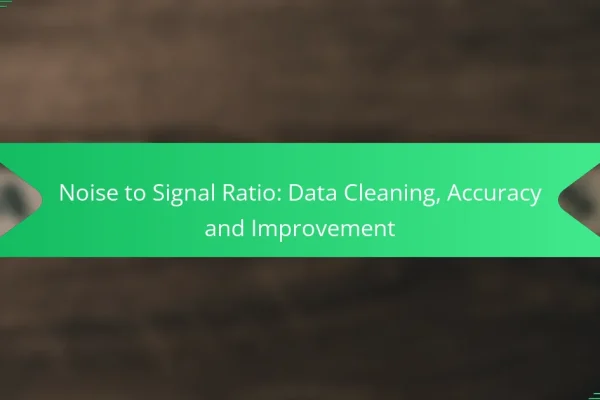How can I improve noise to signal ratio in data collection?
Improving the noise to signal ratio in data collection involves implementing strategies that enhance the quality of data while minimizing irrelevant information. Key methods include data filtering, advanced analytics, and regular audits to ensure that only valuable insights are retained.
Implement data filtering techniques
Data filtering techniques help eliminate irrelevant or redundant information from datasets, enhancing the overall signal quality. Techniques such as low-pass filtering can be applied to smooth out noise in time-series data, while outlier detection methods can identify and remove anomalies that skew results.
Consider using software tools that allow you to set thresholds for data collection, ensuring that only data points meeting specific criteria are included. For example, in environmental monitoring, you might filter out readings that fall outside expected ranges, thus focusing on valid data.
Utilize advanced analytics tools
Advanced analytics tools can significantly improve the noise to signal ratio by applying sophisticated algorithms to identify patterns and trends within data. Tools like machine learning platforms can analyze large datasets to discern meaningful insights that would be difficult to detect manually.
When selecting analytics tools, prioritize those that offer real-time processing and visualization capabilities. This allows for immediate identification of noise and helps in making timely decisions based on clean data.
Enhance data validation processes
Enhancing data validation processes ensures that only accurate and reliable data enters your systems. Implementing checks at various stages of data collection can help catch errors early, reducing the amount of noise in your datasets.
Consider using automated validation rules that flag inconsistencies or missing values. For instance, if collecting survey data, ensure that responses fall within expected parameters, such as age ranges or valid response options, to maintain data integrity.
Adopt machine learning algorithms
Machine learning algorithms can be instrumental in improving the noise to signal ratio by learning from data patterns and automatically filtering out noise. These algorithms can adapt over time, becoming more effective at distinguishing between valuable signals and irrelevant noise.
For practical application, consider supervised learning models that require labeled data to train effectively. This approach can help in scenarios like fraud detection, where distinguishing between legitimate and fraudulent transactions is crucial.
Conduct regular data audits
Regular data audits are essential for maintaining a high noise to signal ratio. By systematically reviewing data quality and relevance, organizations can identify areas where noise is prevalent and take corrective actions to improve data collection processes.
Set a schedule for audits, such as quarterly or bi-annually, and involve cross-functional teams to ensure comprehensive reviews. During audits, assess data sources, collection methods, and filtering techniques to identify potential improvements.
What tools can help optimize data collection?
Several tools can significantly enhance data collection by improving accuracy, visualization, and analysis. Utilizing the right software can streamline processes and reduce noise in the data, leading to more reliable insights.
Google Analytics for web data
Google Analytics is a powerful tool for collecting and analyzing web data. It tracks user interactions on websites, providing insights into traffic sources, user behavior, and conversion rates. By setting up goals and events, users can focus on key performance indicators that matter most to their business.
To optimize data collection with Google Analytics, ensure proper tagging of pages and events. Regularly review and adjust your tracking settings to align with changing business objectives, which can help maintain data relevance and accuracy.
Tableau for data visualization
Tableau is a leading data visualization tool that transforms complex data sets into interactive and understandable visuals. It allows users to create dashboards that highlight trends and patterns, making it easier to communicate findings to stakeholders.
When using Tableau, focus on selecting the right type of visualization for your data. Avoid cluttered dashboards; instead, aim for clarity by using simple charts and graphs that convey the message effectively. Regularly update your data sources to ensure that the visualizations reflect the most current information.
R for statistical analysis
R is a programming language specifically designed for statistical analysis and data visualization. It offers a wide range of packages that facilitate advanced analytics, making it suitable for tasks such as regression analysis, hypothesis testing, and data mining.
To leverage R effectively, familiarize yourself with its syntax and common packages like ggplot2 for visualization and dplyr for data manipulation. Consider using RMarkdown to document your analyses, which can help in sharing reproducible results with colleagues.
Python libraries for data processing
Python offers numerous libraries for data processing, including Pandas for data manipulation and NumPy for numerical analysis. These libraries enable users to handle large datasets efficiently and perform complex calculations with ease.
When working with Python, prioritize writing clean and modular code to enhance readability and maintainability. Utilize Jupyter notebooks for interactive data exploration, allowing for quick iterations and visual feedback on your analyses.
What are the best practices for maintaining data quality?
Maintaining data quality is essential for effective data collection and analysis. Best practices include establishing governance policies, training staff on data handling, and regularly updating data sources.
Establish clear data governance policies
Clear data governance policies outline the standards and procedures for data management within an organization. These policies should define roles and responsibilities, data ownership, and compliance requirements to ensure consistent data quality.
Consider implementing a data stewardship program where designated individuals oversee data integrity and adherence to governance policies. Regular audits can help identify areas for improvement and ensure compliance with established standards.
Train staff on data handling
Training staff on proper data handling techniques is crucial for maintaining data quality. Employees should understand how to collect, store, and process data accurately to minimize errors and inconsistencies.
Offer regular training sessions that cover best practices, tools, and technologies used in data management. Encourage a culture of accountability where staff members feel responsible for the quality of the data they handle.
Regularly update data sources
Regularly updating data sources is vital for ensuring that the information remains relevant and accurate. Outdated data can lead to poor decision-making and skewed analysis results.
Establish a schedule for reviewing and refreshing data sources, whether they are internal databases or external feeds. Utilize automated tools to monitor data quality and flag discrepancies, ensuring timely updates and corrections.
What metrics should I track for data collection efficiency?
To enhance data collection efficiency, focus on tracking the response rate, data accuracy percentage, and the time taken for data processing. These metrics provide insights into how effectively data is gathered, its reliability, and the speed of processing, which are crucial for informed decision-making.
Response rate of data collection methods
The response rate indicates the proportion of participants who provide data compared to those approached. A higher response rate suggests that your data collection methods are engaging and effective. Aim for response rates above 30% for surveys, as this is often considered a good benchmark.
To improve response rates, consider using incentives, simplifying the data collection process, and ensuring clear communication about the purpose of the data collection. Avoid overly complex questions that may deter participants from completing the survey.
Data accuracy percentage
Data accuracy percentage measures the correctness of the collected data compared to the true values. High accuracy is essential for reliable analysis and decision-making. Strive for data accuracy rates of 90% or higher, which is typically seen as acceptable in most fields.
To enhance data accuracy, implement validation checks during data entry, use standardized formats, and regularly audit your data collection processes. Training staff on best practices can also significantly reduce errors.
Time taken for data processing
The time taken for data processing refers to the duration required to clean, analyze, and interpret the collected data. Efficient processing is crucial for timely insights. Aim to complete data processing within a few hours to a couple of days, depending on the volume of data.
To minimize processing time, utilize automated tools and software that streamline data handling. Establish clear workflows and assign responsibilities to ensure that data processing is efficient and organized. Regularly review and optimize your processes to identify bottlenecks and areas for improvement.
What are the common challenges in data collection?
Data collection often faces several challenges that can hinder the quality and reliability of the information gathered. Key issues include data overload from multiple sources, inconsistent data formats, and insufficient data cleaning.
Data overload from multiple sources
Data overload occurs when information is collected from numerous sources, leading to an overwhelming amount of data that can be difficult to manage. This can result in confusion and make it challenging to identify relevant insights.
To mitigate data overload, prioritize data sources based on their reliability and relevance. Implementing a centralized data management system can help streamline the collection process and improve focus on critical data points.
Inconsistent data formats
Inconsistent data formats can create significant barriers in data analysis, as varying formats can lead to errors and misinterpretations. For example, dates may be recorded in different styles, such as MM/DD/YYYY or DD/MM/YYYY, complicating data integration.
Establishing standard data formats before collection can help alleviate these issues. Using data validation tools during the input process can ensure consistency and reduce the need for extensive reformatting later on.
Insufficient data cleaning
Insufficient data cleaning can result in inaccurate or incomplete datasets, which can skew analysis and decision-making. Common issues include duplicate entries, missing values, and outliers that do not reflect the true nature of the data.
To improve data quality, implement regular data cleaning protocols. This includes routine checks for duplicates, filling in missing values where possible, and using statistical methods to identify and address outliers effectively.
How does noise impact decision-making?
Noise can significantly distort decision-making by introducing irrelevant or misleading information into the data collection process. This interference can lead to poor judgments and suboptimal outcomes, as decision-makers may struggle to differentiate between valuable insights and extraneous noise.
Understanding noise in data collection
Noise refers to any unwanted or irrelevant data that can obscure the true signal within a dataset. In data collection, noise can stem from various sources, including measurement errors, environmental factors, or human biases. Recognizing the types of noise present is crucial for improving data quality and ensuring accurate decision-making.
Strategies to reduce noise
To minimize noise, implement robust data collection methods that prioritize accuracy and reliability. This can include using calibrated instruments, standardizing procedures, and training personnel to reduce human error. Regularly reviewing and cleaning data can also help identify and eliminate noise, enhancing the overall quality of the dataset.
Evaluating signal-to-noise ratio
The signal-to-noise ratio (SNR) is a critical measure that compares the level of the desired signal to the level of background noise. A higher SNR indicates clearer data, while a lower SNR suggests that noise is overwhelming the signal. Aim for an SNR that is significantly above 1:1, ideally in the range of 10:1 or higher, to ensure reliable decision-making.
Practical examples of noise reduction
In a marketing campaign, noise might include irrelevant customer feedback or external market fluctuations. To combat this, businesses can segment their audience and focus on targeted surveys to gather more relevant data. In scientific research, employing controlled experiments can help isolate variables, reducing noise and improving the clarity of results.












